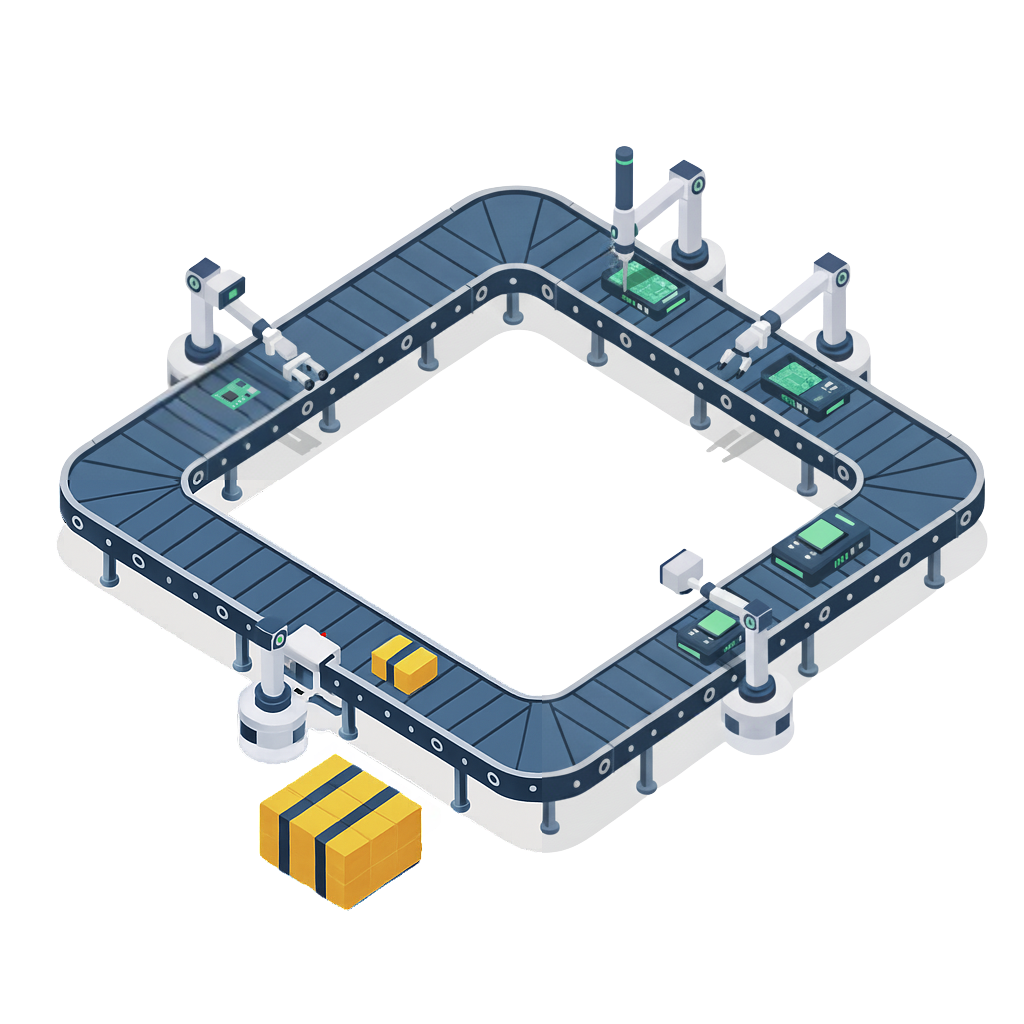Multiply your market impact with go-to-market strategies explicitly built for hardware and devices—not borrowed from SaaS.
Multiply your market impact with go-to-market strategies explicitly built for hardware and devices—not borrowed from SaaS.
Multiply your market impact with GTM strategies built for hardware and devices.
Iterate and learn isn't an option when you've committed to manufacturing 10,000 units.
Technical buyers need specs, procurement needs TCO. Miss any and get stuck in evaluation.
Buyers don't choose based on specs. They care about how your product improves their lives.
Iterate and learn isn't an option when you've committed to manufacturing 10,000 units.
Technical buyers need specs, procurement needs TCO. Miss any and get stuck in evaluation limbo.
Buyers don't choose based on specs. They care about how your product improves their lives.
Manufacturing-Aligned Strategy
vs. Agile Sprint Methodology
We work backward from your manufacturing timeline.
Hardware Success KPI's
vs. Vanity Metrics
We measure pilot conversions, win rates, and market share.

Multi-Stakeholder Messaging
Vs. Single-Buyer Marketing
We build messaging for multiple buyer types and channels.
vs. Bold Outcome Promises
We translate specs into value that customers can see and feel.
Manufacturing-Aligned Strategy
vs. Agile Sprint Methodology
We sequence strategy around manufacturing commitments.
Multi-Stakeholder Messaging
Vs. Single-Buyer Marketing
We build messaging for multiple buyer types across complex sales.

Hardware Success KPI's
vs. Vanity Metrics
We measure pilot conversions, competitive win rates, and market share.
vs. Shaky Outcome Promises
We translate specs into customer value that buyers can see and feel.
The right strategy creates a multiplier effect.
Without a strategic foundation built with input from sales, engineering, and customers, product marketing becomes a checklist—messaging, sales deck, website, data sheet. You're adding tactics to a weak foundation.

When positioning is precise, everything downstream gets easier:
Without a strategic foundation built with input from sales, engineering, and customers, product marketing becomes a checklist—messaging, sales deck, website, data sheet. You’re adding tactics to a weak foundation.

The right strategy creates a multiplier effect.
When positioning is precise, everything downstream gets easier. Sales conversations flow more smoothly, messaging resonates, and every tactic becomes more effective.
Without a strategic foundation built with input from sales, engineering, and customers, product marketing becomes a checklist—messaging, sales deck, website, data sheet. You’re adding tactics to a weak foundation.

The right strategy creates a multiplier effect.
When positioning is precise, everything downstream gets easier. Sales conversations flow more smoothly, messaging resonates, and every tactic becomes more effective.
From pre-launch startups to Fortune 500 (Motorola Solutions, Medtronic), I understand challenges at every growth stage
Medical devices (FDA), telecommunications (FCC), public safety, and life sciences equipment
MBA in Marketing plus cross-functional leadership across product, sales, and engineering teams
From pre-launch startups to Fortune 500 (Motorola Solutions, Medtronic), I understand challenges at every growth stage
Medical devices (FDA), telecommunications (FCC), public safety, and life sciences equipment
MBA in Marketing plus cross-functional leadership across product, sales, and engineering teams
Finalize your positioning, messaging, and GTM strategy before your product ships. We build a foundation that multiplies results from day one — accounting for manufacturing timelines, regulatory requirements, and channel partnerships.
Strategic leadership with full-service execution included. Quarterly planning, positioning optimization, and campaign strategy—plus coordinated creative and digital production. Your embedded marketing leader with a team on standby.
Proven PMM expertise matched to your specific needs and budget. From positioning and launches to ongoing strategic support—flexible engagement without the full-time hire commitment.
Finalize your positioning, messaging, and GTM strategy before your product ships. We build a foundation that multiplies results from day one — accounting for manufacturing timelines, regulatory requirements, and channel partnerships.
Strategic leadership with full-service execution included. Quarterly planning, positioning optimization, and campaign strategy—plus coordinated creative and digital production. Your embedded marketing leader with a team on standby.
Proven PMM expertise matched to your specific needs and budget. From positioning and launches to ongoing strategic support—flexible engagement without the full-time hire commitment.
Pre-launch or post-launch, we build strategies explicitly for physical products—not borrowed from SaaS.
30 minutes on your product and challenges.
30 minutes on your product and challenges.
Discovery and working sessions in 2 weeks.
Updates, reviews, and collaboration.
Our customers’ success stories highlight the real-world impact of our services, showcasing how we’ve helped them overcome challenges, streamline operations, and achieve their goals.
Head of ASEAN Marketing at Red Hat
“Sometimes all it takes is to have a vision for the marketing outcomes that will make a difference, and the ability to amalgamate stakeholders’ feedback/viewpoints to drive a cohesive marketing plan that leaves a lasting impression with targeted audiences. That’s what it’s like working with Ryan – always open to consider new ideas, incorporating cultural nuances as required, and striving for an innovative marketing approach. It was a pleasure partnering Ryan on various global launch campaigns.”
Director of Operations at Lytonn
“Ryan has been nothing short of excellent. His strategy-focused approach and strong grasp of product marketing fundamentals have significantly contributed to our team’s initiatives. His exceptional communication skills ensured efficient and transparent collaboration. We highly recommend Ryan’s services!”
Our customers’ success stories highlight the real-world impact of our services, showcasing how we’ve helped them overcome challenges, streamline operations, and achieve their goals.
Head of ASEAN Marketing at Red Hat
“Sometimes all it takes is to have a vision for the marketing outcomes that will make a difference, and the ability to amalgamate stakeholders’ feedback/viewpoints to drive a cohesive marketing plan that leaves a lasting impression with targeted audiences. That’s what it’s like working with Ryan – always open to consider new ideas, incorporating cultural nuances as required, and striving for an innovative marketing approach. It was a pleasure partnering Ryan on various global launch campaigns.”
Director of Operations at Lytonn
“Ryan has been nothing short of excellent. His strategy-focused approach and strong grasp of product marketing fundamentals have significantly contributed to our team’s initiatives. His exceptional communication skills ensured efficient and transparent collaboration. We highly recommend Ryan’s services!”
Our customers’ success stories highlight the real-world impact of our services, showcasing how we’ve helped them overcome challenges, streamline operations, and achieve their goals.
Head of ASEAN Marketing at Red Hat
“Sometimes all it takes is to have a vision for the marketing outcomes that will make a difference, and the ability to amalgamate stakeholders’ feedback/viewpoints to drive a cohesive marketing plan that leaves a lasting impression with targeted audiences. That’s what it’s like working with Ryan – always open to consider new ideas, incorporating cultural nuances as required, and striving for an innovative marketing approach. It was a pleasure partnering Ryan on various global launch campaigns.”
Director of Operations at Lytonn
“Ryan has been nothing short of excellent. His strategy-focused approach and strong grasp of product marketing fundamentals have significantly contributed to our team’s initiatives. His exceptional communication skills ensured efficient and transparent collaboration. We highly recommend Ryan’s services!”
Whether you’re exploring the basics of cloud computing, comparing our products, or seeking guidance on technical issues, you’ll find the information you need.
Hiring a full-time product marketing manager with relevant industry experience is increasingly challenging—especially if this is your first marketing hire. The average time to hire is now 44 days globally, up from 31 days in 2023. This means companies compete in a compressed timeline while product launches wait.
The Total Cost Breakdown:
Recruiting Costs: $4,700-$20,000 depending on role complexity
Internal recruiter time (if in-house)
External recruiter fees (15-25% of first-year salary)
Job board postings, LinkedIn recruiting tools
Background checks, pre-employment testing
Interview time from multiple stakeholders
Onboarding & Training: $7,500-$28,000
3-6 months before fully productive
Average 33-62 hours of training time
Lost productivity during ramp-up period
Manager and team time investment
Equipment, software licenses, and systems access
Annual Compensation: $130,000-$180,000 for mid-to-senior PMM
Plus benefits (health insurance, 401k, PTO) adding 25-40% = $32,500-$72,000
Total annual investment: $180,000-$250,000+ per year
Total First-Year Investment: $192,200-$298,000 (recruiting + onboarding + full compensation)
And companies haven’t spent a dollar on marketing execution yet—no advertising, creative production, website development, or campaign deployment. Significant budget is exhausted just on the person, who is then expected to operate outside their specialization across all marketing functions.
With Multiplier Effect’s streamlined approach:
2-3 week onboarding through optimized, collaborative discovery (vs. 3-6 months)
Immediate access to specialized expertise in regulated products
Hands-on execution included (strategy + implementation)
Flexible engagement that scales up or down based on launch needs
No long-term overhead, no benefits, no training costs, no recruitment fees
Proven process refined over dozens of physical product launches
Companies get specialized expertise when needed, without the 6-figure commitment and 6-month ramp-up of a full-time hire.
Timeframes vary based on launch complexity, the number of deliverables required, and team decision-making speed. A streamlined sprint focused on core positioning, messaging, and website launch can be completed in 4-6 weeks. More comprehensive launches involving multiple marketing materials, sales enablement assets, and channel strategies typically take 8-12 weeks.
The typical process follows this structure:
Days 1-14: Research & Planning – Market research, competitive analysis, persona development, and strategic alignment
Days 14-16: Strategy Session – Collaborative 2-4 hour workshop to solidify positioning and messaging framework
Days 16-30: Build – Asset creation (website, sales deck, datasheets, training materials)
Days 30+: Launch & Optimize – Launch execution, performance monitoring, and post-launch optimization
For clients needing faster turnaround, Multiplier Effect can accelerate timelines by focusing on minimum viable deliverables first, then iterating based on early market feedback.
This is exactly what the Post-Launch Growth Multiplication service is designed for. Many clients seek help post-launch when initial go-to-market approaches aren’t delivering expected results.
Common scenarios include:
Underperforming launches where technically superior products aren’t gaining traction despite strong engineering
Misaligned messaging that was locked in before proper positioning work, now baked into packaging and channel materials
Sales team struggles where reps can recite specs but can’t effectively communicate value to economic decision-makers
Growth stagnation despite strong product-market fit indicators and positive customer feedback
Marketing funnel inefficiencies with high lead costs, poor conversion rates, or long sales cycles
Post-Launch Growth Multiplication focuses on diagnosing what’s broken and fixing it systematically—whether that’s repositioning, rebuilding sales enablement, optimizing demand generation funnels, or creating competitive intelligence and battle cards teams lack. The advantage of post-launch work is having real market data and customer feedback to inform strategy, rather than operating on pre-launch assumptions.
No two launches have identical needs, but every engagement includes a core foundation: competitive intelligence, persona (ICP) research, and a positioning/messaging strategy document. From there, deliverables are tailored to specific launch requirements.
At minimum, companies need one primary asset to point audiences toward—typically a website, but it could be a sales deck for direct sales motions or a product detail page for launches within existing sites.
Depending on launch scope and service tier, deliverables may include:
Strategic Foundation:
Growth Strategy Blueprint
Market Segmentation Analysis
Positioning & Messaging Framework
Competitive Analysis (SWOT, PESTEL, Porter’s 5 Forces)
Pricing Model Development
Customer Journey Mapping
Sales Enablement:
Competitive Battle Cards
Sales Training Materials
Objection Handling Guides
ROI & Value Calculators
Use Case Libraries
Demo Scripts & Product Walkthroughs
Sales Playbooks
One-Pagers & Leave-Behinds
Channel Partner Programs
Marketing Execution:
Product Website/Landing Pages
Sales Presentations & Pitch Decks
Product Datasheets & Brochures
Case Studies & Customer Stories
Launch Campaign Planning
Video Scripts (sizzle reels, product demos, customer testimonials)
Email Campaign Sequences
Trade Show/Event Materials
Social Media Content Strategy
Every project starts with defining which deliverables will have the greatest impact on specific launch goals, then builds from there. For sales enablement, Multiplier Effect works closely with sales teams to ensure materials are practical, easy to use, and actually adopted in the field—not just created and forgotten.
Physical products can’t be iterated post-manufacturing like software. Once packaging is locked in, 50,000 user manuals are printed, distributors are trained, and the first production run is manufactured, positioning and messaging are essentially fixed. There’s no “push an update” option if the value proposition doesn’t resonate.
Key differences include:
Manufacturing Constraints: Marketing timelines must align with long lead times for packaging, manuals, and channel materials—decisions that SaaS companies can change with a website update.
Regulatory Requirements: Medical devices, life science products, and telecom equipment require compliance-approved messaging that can take months to validate and cannot be quickly adjusted.
Complex Channel Strategies: Physical products often require direct sales teams, distributors, integrators, and channel partners—each needing tailored messaging. SaaS typically has simpler go-to-market motions.
Proof Requirements: Technical buyers need pilots, demos, supply chain verification, and proof-of-concept deployments before committing. These require different marketing approaches than “free trial” or “freemium” models.
Longer Sales Cycles: Enterprise physical product sales involve multiple stakeholders (technical, economic, compliance buyers) over 6-18 month cycles, versus SaaS’s often shorter, digital-first journeys.
Bottom line: Physical product marketing requires getting it right the first time, with less room for experimentation and faster iteration that SaaS teams take for granted.
Multiplier Effect provides hands-on execution, not just recommendations. One of the biggest frustrations companies have with traditional consultants is receiving a beautiful strategy deck with no practical path to implementation.
The Multiplier Effect approach includes:
Creating actual deliverables:
Website copy, sales decks, messaging frameworks, competitive battle cards
Product positioning documents, buyer personas, and GTM playbooks
Sales enablement materials: objection handlers, ROI calculators, demo scripts
Working in client systems:
Integration with CRM, marketing automation, and project management tools
Collaboration in Slack, Teams, or existing communication platforms
Operating within existing workflows and processes
Collaborating with teams:
Working alongside product, sales, and engineering to ensure technical accuracy and commercial appeal
Training teams on how to use deliverables effectively
Transferring knowledge so companies aren’t dependent long-term
Managing creative execution:
Vetted creative partners for specialized needs: designers, video producers, web developers, and copywriters
Oversight of all creative work to ensure alignment with strategic goals
Management of timelines, feedback loops, and quality control
Clients get agency-quality creative without managing multiple vendor relationships
The difference: Companies aren’t left wondering “now what?” after engagements. They have functioning marketing assets, trained team members, and clear execution plans to continue momentum after project transition.